WHITECHAPEL.
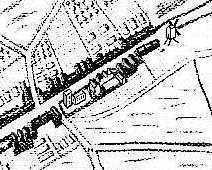 The name Whitechapel came from the chapel called St Mary Matfelon, which had white walls. This was situated in what is now Altab Ali Park . The chapel was originally built in the 13th century and the last of a series of chapels with this name was so badly damaged in World War 2 that it was pulled down after the war. Its floor plan can be seen in the park as can a few of the graves. Matfelon was the name of the family responsible for the 14th century building. On this section of a map of 1746, the church is to the left of centre. Note the surrounding fields and the windmill which stood between the Bell Foundry and what is now the Mosque. |
CONTENTS |
||
| 1. The Albion Brewery | 2. Altab Ali Arch | 3. Altab Ali Park |
| 4. Billboard Supporters | 5. The Blind Beggar | 6. Brady Arts & Community Centre |
| 7. Brick Lane Arch | 8. Canon Barnett School Mural | 9. Nurse Edith Cavell |
| 10. Spitalfields Column | 11.The Elephant Man | 12. Fire Marks |
| 13. Gunthorpe Street Tiles | 14. Hay Market & Art Gallery | 15. Mary Hughes |
| 16. Jagonari Mosaic Doorway | 17. Jewish Daily Post | 18. King Edward VII Fountain |
| 19. Old Lamp Post | 20. Royal London Hospital | 21. Robert Montefiore School |
| 22. "Les Naides" | 23. Osmani School Mosaics | 24. Queen Alexandra |
| 25. Radical Murals | 26. "Ram and Magpie" | 27. St Anne's Catholic Church |
| 28. "Good Samaritan" | 29. Joseph Stalin | 30. Toynbee Hall |
| 31. Tree In The Park | 32. Victoria Cottages | 33. Wash House |
| 34. East London Mosque | 35. Wentworth Street Arch | 14. Whitechapel Art Gallery |
| 36. Whitechapel Bell Foundry | 37. Whitechapel Fountain | |
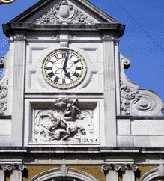 |
The Albion Brewery. | |
There is an imposing building in Whitechapel Road not far from the Blind Beggar. The prominent carving of St George and the dragon on the front beneath the clock might make you think that this was a church. However, this building, set back from the road, was part of the old Albion Brewery. Over the gateway appear the names Mann, Crossman & Paulin. The first brewery on the site was set up in 1808 by the then landlord of the Blind Beggar; but in 1826 James Mann came along and bought him out. (See No. 1. on Map ) |
||
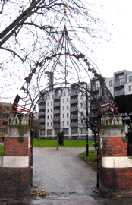 |
Altab Ali Arch. |
|
On the corner of Whitechapel Road and White Church Lane. This arch made by David Peterson was put up as a memorial to Altab Ali and other victims of racial violence. Altab Ali was murdered in Adler Street in 1978 in a racial attack. The arch is partly modern and partly old, because the bases are part of the stone doorway into the "White Chapel" which stood here until it was bombed in World War 2. These bases had been listed to protect them and when the arch was made, the sculptor was only allowed to put one bolt into each base to anchor the arch. The arch follows a Bengali styling and is intended to show a merging of two cultures. (See No. 2. on Map) |
||
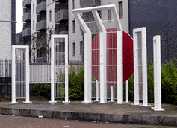 |
Altab Ali Park. |
|
Whitechapel Road. The park is named after Altab Ali, a young man murdered in a racial attack in 1978. This illustration shows the Martyrs' Monument, which was set up in 1999. It symbolises a mother protecting her children with the orb of the sun in the background, and is a smaller replica of Shahid Minar (Martyrs' Monument) in Dhaka in Bangladesh. (See also Altab Ali Arch. and Tree In The Park) (See No. 3. on Map) Sculptor of Memorial: Shaheed Minar. |
||
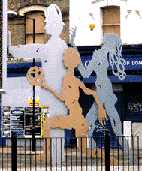 |
Billboard Supporters. |
|
On the island in the middle of the one-way system at Aldgate, facing Commercial Road and a second set facing Commercial Street. There are two groups of figures in silhouette supporting each side of a two large advertising hoardings. The group of figures on right of the billboard (as illustrated) symbolise Summer, while those on the left show Winter. (See No. 4. on Map) Artist: (?) Date (?) |
||
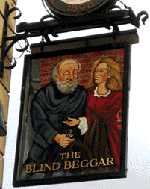 |
The Blind Beggar. |
|
The sign out side the pub in Whitechapel Road, notorious for being the site of a murder by one of the Kray twins in 1966. The blind beggar on the sign is reputed to have had a pretty daughter called Betsey who looked after him while living in Bethnal Green. She had many suitors, but they abandoned her when they found out that her father was a poor beggar. Finally one young man came along who loved her sufficiently not to be put off by this. After the marriage, everyone was surprised to learn that the blind father was by no means as poor as he had led people to believe. There is another explanation which takes the origin back to an Elizabethan ballad called "The Beggar of Bednal Green" which told the story of Henry de Montford who was blinded at the battle of Evesham in 1286 went to live in 'Rumford' and had a daughter called Bessee. The two stories seem to be variations by minstrels of the same original tale. (See No. 5. on Map ) | ||
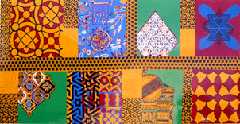 |
Brady Arts & Community Centre. |
|
Hanbury Street., showing one of the artworks on the exterior walls. The building was erected to house the Brady Clubs and Settlement, which were primarily Jewish youth clubs. A number of commemorative stones from this era can still be seen on the front of the building. There is a blue plaque in Princelet Street for Miriam Moses, who was warden here for many years. (See No. 6. on Map) |
||
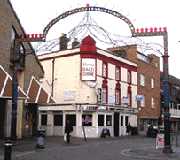 |
Brick Lane Arch. | |
At the end of Brick Lane where it joins Osborne Street. This is now the entrance to "Bangla Town" with its many curry houses. The red and green on the arch have been taken from the colours of the flag of Bangladesh. This arch by Mina Thakur was put up at the end of the last century in 1997. But if you had passed this way in the earlier part of the century, where the right hand column of the arch now is, you would have found a Jewish lady selling beigels, who was a well known local figure. (See No. 7. on Map) |
||
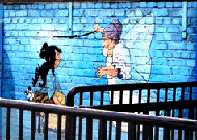 |
Canon Barnett Primary School Mural. | |
Sometimes visible from Commercial Street. This mural in the playground seems to portray a teacher as fairy godmother, waving a magic wand and turning an ignorant little girl into a wise one. The school was originally was originally the Commercial Street Board School and was attached to St Jude's Church, where Revd. Samuel Barnett (1844-1913) was the vicar. He founded this school and the adjacent Toynbee Hall. (See also Gunthorpe St Tiles. For this mural see No. 8. on Map) |
||
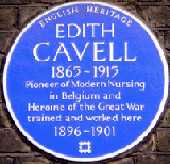 |
Nurse Edith Cavell. | |
In the courtyard behind the central block of the Royal London Hospital on the surrounding buildings, there is a plaque commemorating the fact that Edith Cavell was a nurse at this hospital. In World War 1, Edith Cavell (1865-1915) was a nurse in German occupied Belgium and was arrested and charged with assisting Allied soldiers to escape into neutral Holland. Her execution by the Germans caused an outcry. Nearby Cavell Street is named after her. (See No. 9. on Map) |
||
 |
Spitalfields Column. |
|
The Aldgate end of Middlesex St, amongst some roadside greenery, there is what appears to be a carved stone totem pole. In fact it has carvings of animals and people which are intended to symbolise the trading that took place in this area. (See No. 10. on Map) Sculptor: Richard Perry, date: 1995. |
||
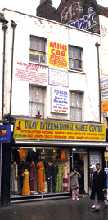 |
The Elephant Man. |
|
259 Whitechapel High Street. It was in a shop previously situated here, that Dr Frederick Treves from the Royal London Hospital opposite, first met Joseph Merrick. Merrick suffered from a medical condition which caused excessive and uneven growth of bone. In his case, it was the skull which was deformed. His head grew to more than twice the size of a normal man and appeared grotesque. He was being displayed as a freak and was treated as if he were an animal. Treves eventually found him a room in The London Hospital where he could live quietly, away from the gawping crowds. The condition was not curable and he lived here until his death in 1890, aged 27. A film was made about his sad life called "The Elephant Man". (See No. 11. on Map) |
||
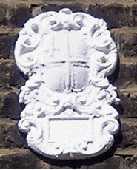 |
Fire Marks. |
|
In Mount Terrace, small lane off New Road ending just underneath the London Hospital helipad, there is a row of old houses. Many of these display fire marks, which seem to be linked with the city of London. In the days before municipal fire services, insurance companies often had their own fire engines. They issued badges to be fixed to the front of houses they had insured, so that their fire crews would know which houses they should be saving. Several cases were reported of fire crews refusing to extinguish fires in houses insured by rival companies. Mount Terrace got its name from the large mound some 30 or 40 foot high which stood on this corner until the end of the 18th century. In the civil war the Parliamentary forces used it as central feature of their defence of London against the Cavaliers. It never saw action, but there was one Civil War skirmish at Bow Bridge about a mile down the road. (See No. 12. on Map) |
||
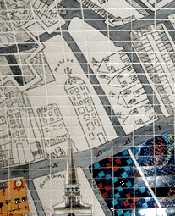 |
Gunthorpe Street Tiles. |
|
Just off Whitechapel High Street under the arch leading into Gunthorpe Street. This was designed by the pupils of Canon Barnett School in a project under the artistic direction of Rachel Johnstone, and was part of the Bethnal Green City Challenge. Canon Samuel Barnett (1844-1913) played a large part in improving the lives of the East End residents at the end of the 19th century. Besides founding this school, he was the moving spirit behind the founding of Toynbee Hall and also of various housing projects. (See No. 13. on Map) |
||
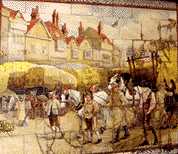 |
Hay Market. |
|
Whitechapel Library, Whitechapel Road. Inside the entrance hall of the Library there used to be a picture composed of glazed tiles which depicts the local Hay Market in 1788. Hay was still being brought in on carts and sold in Whitechapel until 1928, when the market was abolished by an Act of Parliament. It is thought that this picture was originally displayed in a pub. There is further evidence of the rural side of the area under the railway bridge over Commercial Road by Yorkshire Road where there is an inscribed drinking fountain and cattle trough dated 1886. Because it is called a cattle trough and not a horse trough it must have been intended for the use of cattle being driven up Commercial Road to the East End slaughter houses. The Library was closed in 2005 and it is hoped that this picture will be displayed in the Whitechapel Art Gallery. before 2008. (For the Hay Market see No. 14. on Map) The tiles date from 1888. | ||
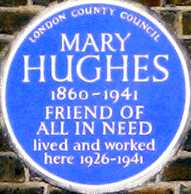 |
Mary Hughes. |
|
On the wall of 71 Vallance Road, which is on the corner with Buxton Street. Mary Hughes (1860 � 1841) was the daughter of Thomas Hughes who wrote Tom Brown's School Days. Inspired by her father's social work and her own experience of the work of Kingsley Hall, in 1926, Mary opened up this building. which had previously been a pub called "The Earl Grey", as a hostel for the homeless and needy, and called it the "Dewdrop Inn". (Her social work was far better than her puns). A block of low-rent flats called Hughes Mansions, also in Vallance Road, was named after her. On May 27th 1945, a whole wing of these flats were destroyed by one of the last V2 rockets to fall on London. This killed 134 residents and seriously wounded a further 49. (See No. 15. on Map) |
||
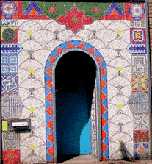 |
Jagonari Mosaic Doorway. |
|
Mosaic surround to the entrance of Jagonari, Women's Educational Resource Centre, 183�5 Whitechapel Road, E1. There is a second mosaic above the doorway. Both are in an Eastern style, which brightens up the area. Art is among the various subjects taught in this building. Notice that there is no representation of a human or animal figure. (See No. 16. on Map) Artist: Teena Gould, 1987 |
||
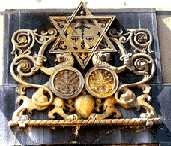 |
The Jewish Daily Post. |
|
88 Whitechapel High Street. The building was occupied for a time by the Jewish Daily Post, a short-lived daily newspaper. Some of the symbols are recognisably Jewish. The Star of David became a Jewish symbol about the 12th century of the current era, while the seven-branched lamp goes back to temple times and the lions were linked with the tribe of Judah in biblical times. (See No. 17. on Map) Designer: Arthur Szyk. |
||
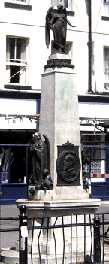 |
King Edward VII Fountain. |
|
|
Drinking fountain opposite the Royal London Hospital Whitechapel E1 and erected in 1911 to commemorate the life of King Edward VII. The monument was put up by members of the Jewish community in the same year. The statuary was originally cast in bronze; but this was stolen so often that it has long since been replaced by casts in a cheaper material. (See No. 18. on Map ) . (For other Jewish sites please see Jewish East End Today and Old Jewish Synagogues and Cemeteries ) Designer: William S Frith. 1911. |
||
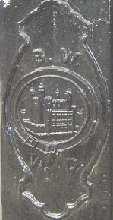 |
Old Lamp Post. |
|
An elaborately decorative lamp post in Whitechapel Road, on the corner by the Whitechapel Bell Foundry. The design shows the central keep of the Tower of London. Round the outside of this are the letters B W above and W D below. On its sides it is dated 1899. These initials stand for the Board of Works Whitechapel District, which together with Hampstead, Lambeth and Shoreditch, was granted permission in 1882 and 1888 to install Electric street lighting. The power for the Whitechapel lights came from the electricity supply station in Osborne Street, which opened in 1899 using steam driven generators. So this lamppost is one of the earliest examples of electric street lamps in East London. The lamp has had to be adapted to use AC, as original power was Direct Current. (See No. 19. on Map) |
||
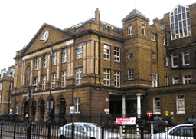 |
Royal London Hospital. |
|
A landmark building on Whitechapel Road. A world-renowned teaching hospital, first established as a dispensary in 1740 in a few houses just off City Road, and then in Prescot Street; it opened up on its present site in 1757. It has been serving patients in East London ever since. Queen Alexandra was closely associated with the hospital and there is a fine statue of her in the courtyard behind. In more recent years it has added a heliport for an air ambulance and has joined up with Barts to form one health group. A new plan has recently (2006) been approved for modernising the hospital. The ground floor corridors usually have displays of paintings which are changed from time to time. While walking past the hospital one might like to notice the unusual row of Carob trees (St John's bread) which grow in the pavement to the west of the main entrance. The fruit can be clearly seen in winter months. (See No. 20. on Map) |
||
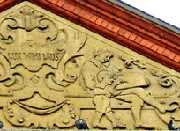 |
Robert Montefiore School. |
|
Hanbury Street. The gable end shows the teaching of a young child. The inscription reads LUX MIHI LAUS. Which means "Education brings me praise". Capt. Robert Montefiore (1882-1915) was killed in World War 1. The building now houses a children's nursery and serves as an adult education centre (See No. 21. on Map) |
||
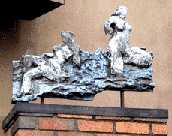 |
"Les Naides" |
|
One of a set of four sculptures of bathers placed outside number 45 Whitechapel Road, E1. This was the winner of a competition arranged by the Whitechapel Art Gallery for a work to occupy this space. Previously a Mikveh (a Jewish ritual bath mostly used by women) had stood on this site. However some members of the local council objected to the design. It may have been because of the nudity; but they said it was sexist and thought it tasteless, as the area was still remembered for the Jack the Ripper murders, all of whose victims were women. The objections delayed the erection of the art work, and the brick pillars remained empty for some time before the bronzes were finally installed. (See No. 22. on Map) Sculptor: Ivor Abrahams, RA. 1985. |
||
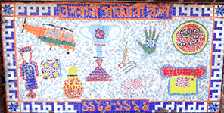 |
Osmani Primary School Mosaics. |
|
54 Vallance Road. One of two mosaics outside the school produced by pupils in 1996 to mark the tenth anniversary of the school. The other mosaic has an inscription in English. (See No. 23. on Map) |
||
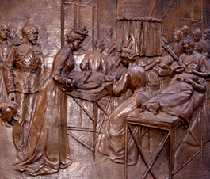 |
Queen Alexandra's Statue. | |
Situated in the courtyard behind the Royal London Hospital, Whitechapel Road, there is an impressive statue of the wife of King Edward VII. This illustration shows a detail from the rear of the base of the memorial, showing a visit to the hospital by the King and Queen and the treatment being given by nursing staff a century ago. Queen Alexandra was influential in bringing in into the hospital the Finsen lamp, then a new treatment for tuberculosis of the skin. (See No. 24. on Map) Artist: George Edward Wade. 1908. (See also the William Booth Statues by the same artist.) |
||
| ||
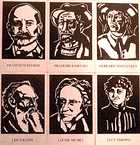 |
Radical Murals. |
|
Angel Alley, off Whitechapel High Street. This is in an inconspicuous alley inappropriately placed next to KFC. The murals are on the walls of the Freedom Press Bookshop and Publishers (Anarchist). The illustration shown here is just a part of a larger work depicting radical writers and artists. From left to right and from top to bottom they depict:
Artist: Anya Patel. |
||
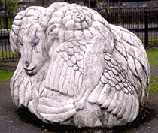 |
"Ram and Magpie" |
|
Allen Gardens Playground, Buxton Street, E1. This was one of the works which was commissioned under the Bethnal Green City Challenge. The sculpture was inspired by a pub by this name which had stood on this site in the early twentieth century. The block of stone was installed on the site and the sculptress carved it where it now stands. Buxton Street is named after Thomas Buxton (1786-1845), of the brewers Truman, Hanbury and Buxton, who became an MP who campaigned for Prison Reform and abolition of the slave trade. (See No. 26. on Map) Sculptress: Paula Haughny, 1996. (See also by the same sculptress: "Dockers' Memories", "Exotic Birds" and 6 other works, "Heron, " etc, "Lord Mayor's Dragon", "The Passenger" and "Smiling Beast".) |
||
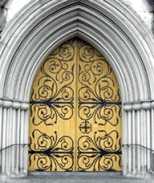 |
St Anne's Catholic Church. |
|
Underwood Road, E1. Decorative doorway. The functional iron banding to strengthen the door has here become an artistic design. This church was opened in 1855. (See No. 27. on Map) |
||
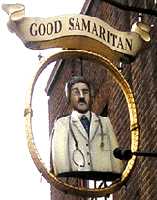 |
The Good Samaritan |
|
Sign on a Public house behind the Royal London Hospital. The pub is on the corner Turner Street and Stepney Way. This is one of several such signs on the pub, each showing a white-coated doctor with a stethoscope round his neck. In each case the stethoscope seems to be a real one, but partly damaged. The sign shows the appreciation that has been felt by generations of Eastenders for the work of the hospital. The story of the Good Samaritan comes from Luke , ch. 10, 30 ff. (See No. 28. on Map) |
||
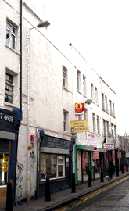 |
Joseph Stalin and a Ducking Pond. |
|
Fulbourne Street running off Whitechapel Road almost opposite the London Hospital Helipad. One of the buildings down here (but probably no longer standing) was the meeting place of a Social Club. In May 1907 it was hired by Bolsheviks to hold a caucus meeting before the 5th congress of the Russian Social Democratic Labour Party. These left-wing Russian activists were hounded in Russia, but were able to travel to Britain for their conference. Several of the 105 delegates who came to this meeting in Stepney became famous or infamous. They included Vladimir Ilyich Lenin, Leon Trotsky, Joseph Stalin, Maxim Gorky, Maxim Litvinov and Rosa Luxemburg. During the fortnight of the conference Stalin (then called Djugashvili) and Litvinov slept in a hostel for down-and-outs in Fieldgate Street. (See No. 29. on Map) A Map of 1829 shows that there used to be a small lane called Ducking Pond Row which crossed Fulbourne Street about where the District Line now is. The pond was near the present Brady Street. Ducking ponds were used at one time to find witches and to punish disobedient or scolding wives as well as male drunkards. |
||
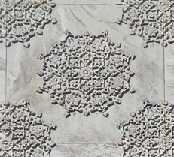 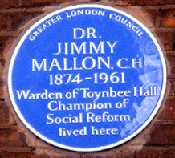 |
Toynbee Hall. |
|
Commercial Street. Founded in 1883 by Revd. Samuel Barnett and named after the historian Arnold Toynbee. Toynbee had been involved in social work in the East End before his early death. This was set up as a settlement so that University graduates and students could come and do social and educational work to ameliorate the dreadful poverty, ignorance and vice which was then so common in the area. It was hoped that the working classes would gain education and that the academics would become more worldly and practical. Later a number of other settlements followed this example. The illustration shows a detail from a large sculptural design that is on the wall of Atlee House which was erected in 1971. Clement Attlee had been secretary at Toynbee Hall before going on to be mayor of Stepney and eventually becoming Prime Minister. (See No. 30. on Map) Jimmy Mallon was one of a series of the great men who had served as wardens at Toynbee Hall. |
||
 |
Tree In The Park. |
|
Altab Ali Park, Whitechapel Road. Until World War 2 this whole area was occupied by the chapel known as St Mary Matfelon, which dated back to the thirteenth century. A drinking fountain, few of the gravestones and part of the gateway remain from the churchyard. The Chapel was damaged by bombing and was finally demolished in 1952. But the outline ground plan of the building is preserved by stonework in the grass (top left in picture). The early chapel must have had white walls, because this is the reason why this area is called Whitechapel. In 1710, the Rector of St Mary's, who had fallen out with the Dean of Peterborough, ordered a new altarpiece which showed the villain, Judas Iscariot, depicted with the features of the Dean. The Bishop of London had to intervene and order the removal of altarpiece. In contrast to this story, the lettering in the path spells out "Shade of my tree is offered to those who come and go fleetingly." A quotation from a poem of Rabindranath Tagore who was the Nobel Prize winner for literature in 1911. (See No. 31. on Map) | ||
 |
Victoria Cottages. |
|
Off Deal Street. This is one of two terraces of cottages erected in 1857 as part of a planned development to improve the quality of the living conditions in the area. A second terrace called Albert Cottages was built a few years later. (See No. 32. on Map) |
||
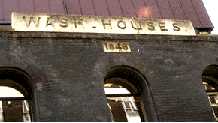 |
Wash House. |
|
Old Castle Street. The front wall of the Wash Houses erected in 1846 have been preserved behind them there is now the Women's Library. Following outbreaks of Cholera in the East End due to unsanitary conditions then existing, The Committee for Promoting the Establishment of Baths and Washhouses for the Labouring Classes put up the original building. Eventually there were a number of public bath houses in the area to compensate for the lack of washing facilities in the existing apartments. (See No. 33. on Map)
|
||
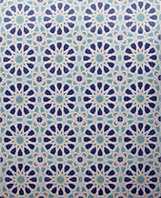 |
East London Mosque. |
|
Whitechapel Road, E1. Design on the front exterior of the building. There is no representation of human or animal figures on Mosques, so all designs are decorative. The Mosque was built by John Gill Associates. (See No. 34. on Map) Date: 1982-85. |
||
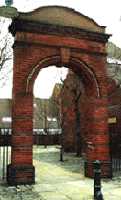 |
Wentworth Street Archway. | |
In Wentworth Street, east of Commercial Street. This arch, which used to be the entrance to the Charlotte de Rothschild Model Dwellings, has been preserved to commemorate an enlightened scheme to improve the standard of housing for working class families. In 1885, Nathaniel, later Lord, Rothschild called together some prominent figures in the Jewish community, and persuaded them to form the Four Per Cent Industrial Dwellings Company. The company agreed to limit it's profits to 4% rather than the usual 8% or more that other property companies then aimed at. Such a limit enabled them to charge lower rents to the occupants. Within 11 years, the company had built good accommodation for 4000 people. Nathaniel Close, seen through the arch, was named after Lord Rothschild. Charlotte de Rothschild was Nathaniel's mother. (See No. 35. on Map) |
||
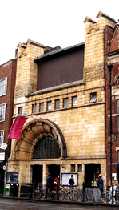 |
Whitechapel Art Gallery. |
|
Whitechapel Road, next to the eastern entrance to Aldgate East tube station. This is a striking Art-Nouveau building of c. 1900, designed by Charles Townsend who was also the architect of the Bishopsgate Institute. The key figure behind this important cultural centre in the East End was Henrietta Barnett, wife of Canon Barnett. Admission is usually free and donations are asked for. However, there are admission charges for special exhibitions. (See No. 14. on Map)
|
||
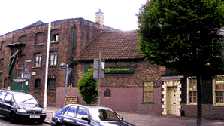 |
Whitechapel Bell Foundary. |
|
On the corner of Whitechapel Road and Plumbers Row. This is thought to be the oldest firm in the country, still carrying out its original trade. It claims to have been established in 1570. But it has only been in its present premises since 1738. On the side wall of the building there is a very old carved stone street sign saying: "This is Baynes Street 1746." The street had its name changed many years ago. This sign is now difficult to read after the passage of time. The wall was just too late to be shown on the 1746 map at the top of this page. There is an even older street sign in Sclater Street. (For location see No. 36. on Map) |
||
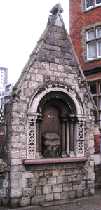 |
White Chapel Fountain. |
|
On the corner of Whitechapel Road and White Church Lane. The inscription states that this fountain had been in the Old Church railing and was moved here in 1879, and that it was "Erected by one who is known yet unknown." Presumably, the benefactor wished to remain anonymous. Round the central fountain is written:
(The grey letters are damaged and may not be correct) The old chunk of stone in the centre has a hole, from which presumably the water came out. In the 19th century, when this was first built, drinking fountains providing clean water were an important means of preventing the frequent cholera epidemics that caused many deaths in the East End. (See No. 37. on Map) |
||
OTHER AREAS COVERED:-
|| Beckton || Bethnal Green || Blackwall || Bow || Bromley-by-Bow || Canary Wharf || Canning Town || Chingford || Cubit Town || Custom House || East Ham || East India Dock || Forest Gate || Higham's Park || Leyton || Leytonstone || Limehouse || Little Ilford || Manor Park || Mile End || Millwall || North Woolwich || Plaistow || Plashet || Poplar || St George's || St Katharine Dock || Shadwell || Shoreditch || Silvertown || Snaresbrook || Spitalfields || Stepney || Stratford || Upton || Walthamstow East || Walthamstow Village || Walthamstow West || Wanstead || Wapping || West India Dock || Woodford || |
 www.thewomenslibrary.ac.uk
www.thewomenslibrary.ac.uk